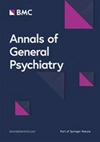自杀企图者和非自杀企图者重度抑郁症(MDD)患者的脑源性神经营养因子和C反应蛋白(CRP)生物标志物
IF 3.6
3区 医学
Q1 PSYCHIATRY
引用次数: 0
摘要
在现有文献中,有报道称抑郁症患者的 BDNF 和 CRP 水平与自杀有关,但结果并不一致。我们的目的是评估和比较有自杀企图(MDD + SA)和无自杀企图(MDD-SA)的 MDD 患者与健康对照组的 BDNF 和 CRP 浓度。研究共招募了 30 名(MDD + SA)患者、30 名(MDD-SA)患者和 26 名健康对照者。研究人员记录了患者的年龄、性别和体重指数。采集血液样本用于测量 BDNF 和 CRP。此外,还记录了吸烟史、吸毒史、家族自杀史和自残史。数据使用 SPSS 22 版和 R 4.1.1 版进行分析。三组共 86 名患者接受了评估(平均年龄:28.45 ± 9.27 岁,女性占 56.71%)。除自残(MDD + SA、MDD-SA 和健康对照组分别为 40%、3.3% 和 0%,P = 0.001)外,基线和人口统计学参数在组间无差异。CRP 水平在组间无明显差异。BDNF在组间有显著差异(三组分别为17.35、16.45和19.43,P<0.001)。BDNF 的增加降低了抑郁和自杀的几率。Roc 曲线显示,BDNF 在区分 MDD 组和健康组方面具有极佳的能力。在我们的研究中,有/无自杀企图的抑郁症患者与健康对照组之间的 BDNF 浓度存在显著差异,这表明 BDNF 与抑郁症的发展有关,而与自杀企图无关。我们没有发现 CRP 水平与自杀未遂之间有任何关联,但仍需要更大规模的研究才能得出明确结论。本文章由计算机程序翻译,如有差异,请以英文原文为准。
Brain-derived neurotrophic factor and C-reactive protein (CRP) biomarkers in suicide attempter and non-attempter major depression disorder (MDD) patients
In the available literature, levels of BDNF and CRP have been reported to correlate with suicide in depressive patients but there are inconsistencies in the results. We aimed to evaluate and compare BDNF and CRP concentrations in MDD patients with(MDD + SA) and without suicide attempts (MDD-SA) and healthy controls. 30 (MDD + SA) patients, 30 (MDD-SA) patients, and 26 healthy controls were enrolled in the study. Age, sex, and BMI of patients were recorded. Blood sample was obtained for measurement of BDNF and CRP. Smoking and drug history, family history of suicide, and history of self-harm were also documented. Data were analyzed with SPSS version 22 and R version 4.1.1. 86 patients in three groups were evaluated (mean age: 28.45 ± 9.27 years, 56.71% female). Baseline and demographic parameters except for self-harm (40%, 3.3%, and 0% for MDD + SA, MDD-SA, and healthy controls, respectively, p = 0.001) did not differ between groups. CRP level was not significantly different between groups. BDNF showed a significant difference between groups (17.35, 16.45, and 19.43 for three groups, respectively, p < 0.001). An increase in BDNF decreased the odds of both depression and suicide. Roc curve showed excellent power for BDNF in discriminating MDD groups With healthy group.Roc can notdicrimiate MDD + SA and MDD-SA. In our study, the concentration of BDNF differed significantly between depressed patients with/without suicide attempts and healthy controls which shows the association of BDNF with depression development and not suicide attempts. We could not find any association between CRP level and suicide attempt but still larger cohorts are needed for a definite conclusion.
求助全文
通过发布文献求助,成功后即可免费获取论文全文。
去求助
来源期刊

Annals of General Psychiatry
PSYCHIATRY-
CiteScore
6.60
自引率
2.70%
发文量
43
审稿时长
>12 weeks
期刊介绍:
Annals of General Psychiatry considers manuscripts on all aspects of psychiatry, including neuroscience and psychological medicine. Both basic and clinical neuroscience contributions are encouraged.
Annals of General Psychiatry emphasizes a biopsychosocial approach to illness and health and strongly supports and follows the principles of evidence-based medicine. As an open access journal, Annals of General Psychiatry facilitates the worldwide distribution of high quality psychiatry and mental health research. The journal considers submissions on a wide range of topics including, but not limited to, psychopharmacology, forensic psychiatry, psychotic disorders, psychiatric genetics, and mood and anxiety disorders.
 求助内容:
求助内容: 应助结果提醒方式:
应助结果提醒方式:


